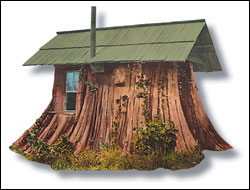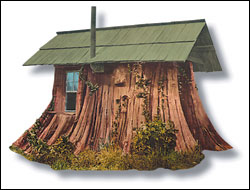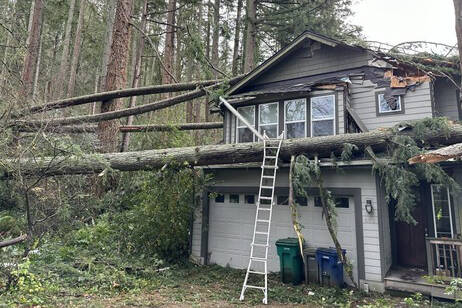Recently I took a short trip down to Paul Allen’s Discovery Center, the sales showroom for his Vulcan holding company on the corner of Westlake Avenue North and Denny Way. It’s an architecturally splendid “green” and portable building that sits in a neighborhood once famed for car dealerships. Now they’re dealing in condos.
Inside, it feels like a world’s fair pavilion. As you walk through, there’s a timeline and a display of artifacts from the Museum of History and Industry (and from, no kidding, historian Paul Dorpat’s basement) that helps visitors track Seattle’s boom cycles and puts Allen’s South Lake Union plan in historical context. There’s a circular mini- theater that shows a film about what life in the neighborhood might be like in 2010 if Vulcan’s development agenda comes to pass. It’s a rosy future: bars, coffeehouses, REI yuppies, trolleys—nothing like we have today, of course. An upbeat newscast from 2010 featuring a hasn’t-aged-a-day Joyce Taylor casually refers to the Seattle Mariners being in the hunt for their second consecutive world title, just to remind you this is fantasy.
The pavilion also features scale models of some of the projects Vulcan is developing in the South Lake Union neighborhood, where it owns about 60 acres of property. Prospective condo buyers can come and look at dollhouse layouts complete with miniature furniture, art, and food to help buyers pick out their new in-city dwellings. The Lilliputians clearly belong to a well-heeled urban gentry—I spotted a tiny table with microscopic sushi on it. It’s hard not to envy the invisible urban mini-mes who’ll be lucky enough to afford these places. A postage-stamp studio is the price of a starter home.
But the Discovery Center’s centerpiece is a giant scale model of north downtown and South Lake Union. Use of such dioramas was pioneered at world’s fairs, like New York’s in 1939, where people could tour a miniature World of Tomorrow. Allen’s city gives you a God’s- or Godzilla’s-eye-view of Seattle. You press buttons to illuminate lights that indicate amenities such as the proposed trolley line and the monorail. Property owned by Allen is identified. Little models show a mix of existing and proposed buildings. It’s like the Land of Counterpane from the Robert Louis Stevenson poem— Allentown as a boy’s fantasy landscape.
As such, it is an incredibly potent piece of propaganda. The city it shows does not exist. Its blend of fantasy and reality incorporates mere ideas as well as actual drawing-board proposals. In the model Allentown, the so-called Mercer Mess of traffic has been fixed with beautiful tree-lined streets and a street grid completed over a sunken Aurora Avenue North, which, presumably, leads to an underground waterfront “viaduct.” You can see where the proposed neighborhood trolley line would run; you can see people enjoying the South Lake Union waterfront park. You can see future biotech-research buildings, and you are invited to imagine an urban center built around the so-called life sciences. No price tags, of course.
You are also invited—no, nearly compelled—to use your imagination. Some of the city is rendered realistically, but much is rendered semi-abstractly. And, of course, much is left out. But it is a cleverly crafted slate on which you can co-project the future along with Paul. It exists in a time frame that is unreal—part present, part future, part abstraction. It exerts a weird magic: As you gaze down at it, it takes on the aura of inevitability. It’s like a tall drink of Kool-Aid. You like this plan, you want this plan, this is the plan. It seems at once grand and doable.
It isn’t the only grand plan for Seattle. Greg Nickels has his downtown Manhattan Project. The People’s Waterfront Coalition is fleshing out how Seattle would look if the viaduct weren’t replaced at all—the kind of dense, sustainable city that could rewire itself after removing an intrusive waterfront highway. And recently, a group of community leaders released the Cascade Agenda, a massive, long-term vision of how to protect rural lands and wilderness in King, Snohomish, Pierce, and, wisely, Kittitas counties. Saving such lands won’t be the result of mere densification but of aggressive, expensive efforts to preserve what we are about to lose if we let the market have its way.
But you have to give Paul Allen credit, for while his vision is less bold, it is rendered most tangibly. He has realized that the race to the future will be won by a two-pronged campaign fought in the trenches and in the stars. His staff is fighting for South Lake Union in the streets—lobbying, planning, organizing, co-opting, cajoling, selling. Yet they’re also investing in getting their vision out there in three dimensions. No one else has articulated a more compelling alternative that the public can see, feel, and imagine. Is there anyone else who can afford to?
While Nickels is talking about more high-rises downtown, it’s Allen who is filling the vision vacuum. It’s a self-interested vision; the multibillionaire makes no bones that he’s in it to make even more money. At Paul’s pavilion, you’ll get a taste of the good life he’s after. But whether you’re seduced or repelled by it, you come away thinking that those who have alternative visions must find a way to get them out there in a form as compelling. Otherwise, Allen’s future might become ours by default.







